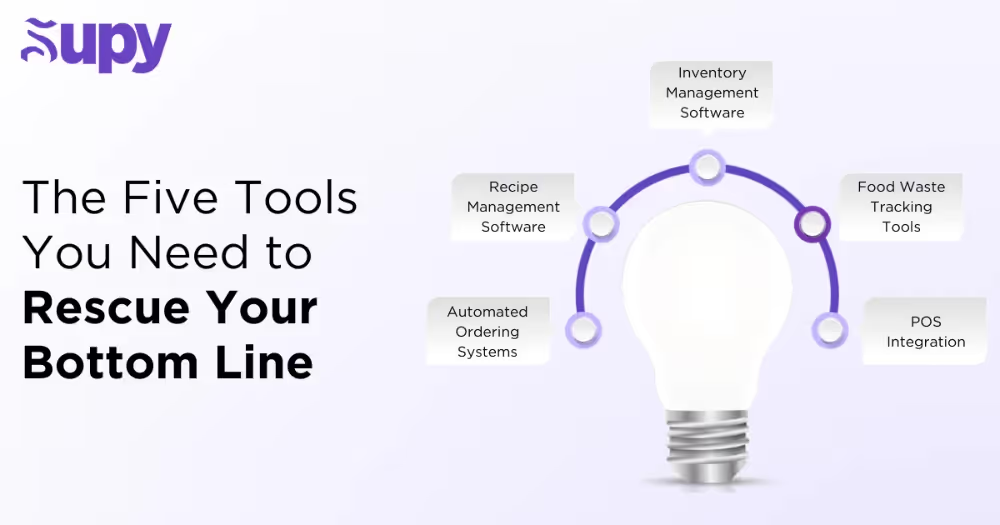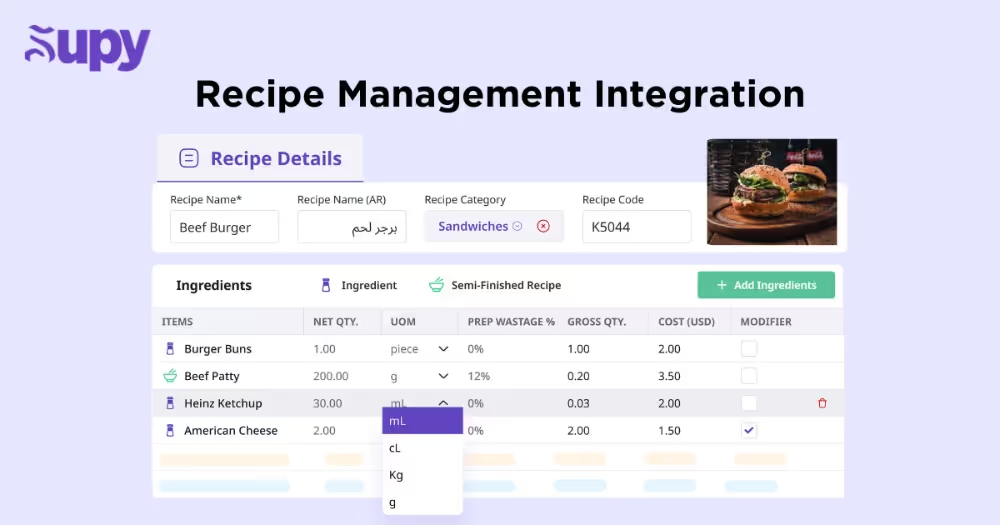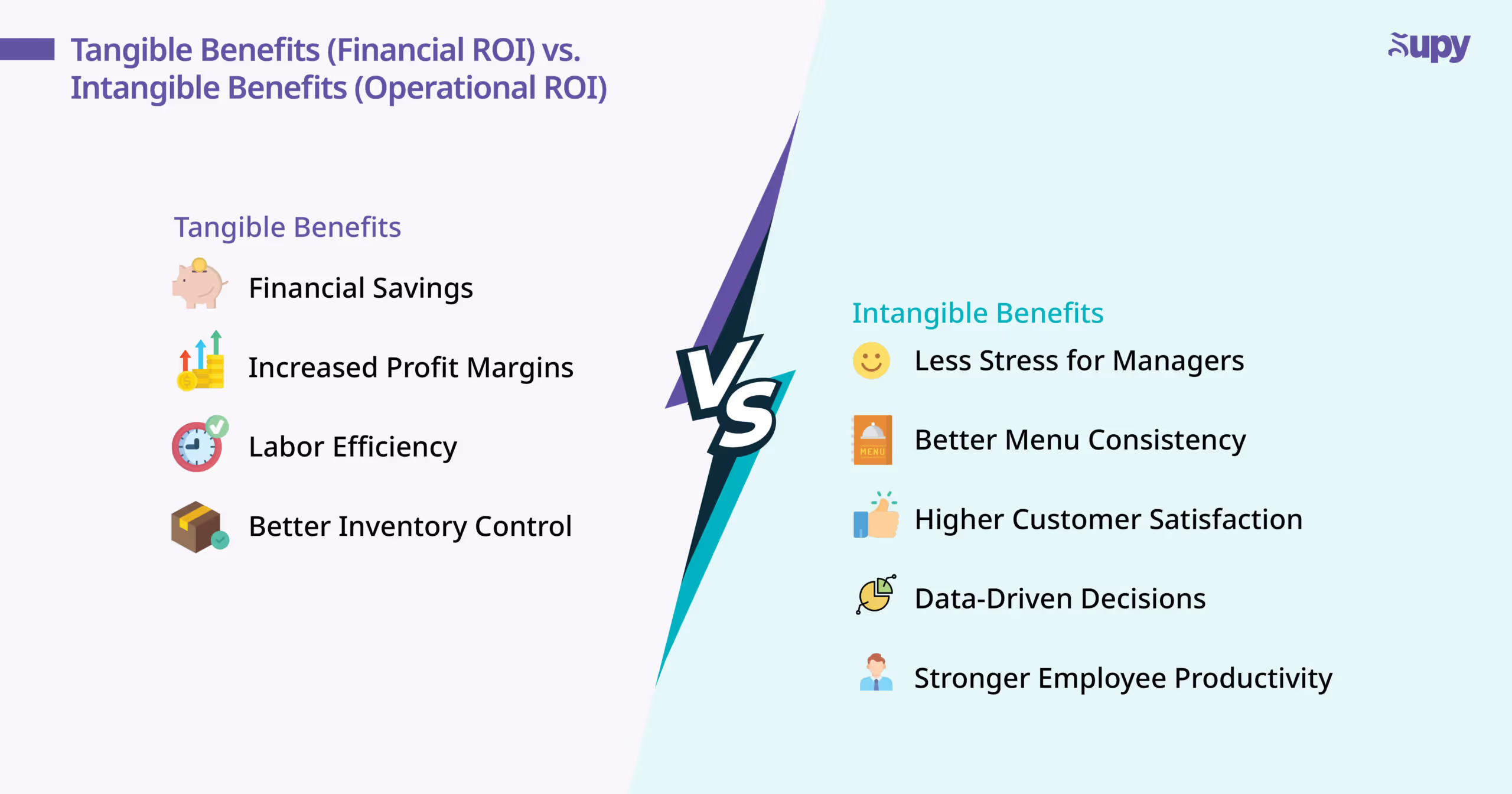The ROI of Restaurant Inventory Management Systems: Why It Pays Off

Every restaurant operator faces the same question when considering an inventory management system: "Is it worth the cost?" It’s a fair concern. With tight margins and rising operational expenses, every investment must justify itself. An inventory management system is a tool that reduces waste, controls food costs, and increases profitability.
More than 50% of restaurant operators already use some form of inventory management software to track and manage stock. Manual tracking and guesswork create too much room for error, leading to unnecessary losses. Food prices fluctuate, labor costs rise, and restaurants relying on outdated methods struggle with shrinking margins.
This article breaks down the specific financial benefits of an inventory management system with real numbers and logical reasoning. We'll cover:
- The Cost of the Status Quo: A Four-Question Test for Your Restaurant’s Profitability
- Waste Reduction – Direct Savings
- Improved Cost of Goods Sold (COGS) – Better Profit Margins
- Labor Efficiency – Management Hours Reclaimed
- Preventing Stockouts – Preserving Revenue
- Optimized Purchasing and Supplier Deals – Lower Costs, Better Margins
- Real-World Impact – How Supy Helps Restaurants Improve ROI
- ROI Timeline – When Do the Savings Exceed the Cost?
- Intangible Benefits – Better Control, Consistency, and Decision-Making
- Conclusion
- About Supy
1. The Cost of the Status Quo: A Four-Question Test for Your Restaurant’s Profitability

Is skipping an inventory management system really saving money? Many restaurant owners believe so, but the numbers tell a different story. Hidden costs: food waste, theft, stockouts, and excessive labor hours, slowly eat away at profits, often without notice.
Let’s take a four-question approach to uncover how much these inefficiencies are costing your restaurant.
Food Waste: How Much Are You Throwing Away?
Food waste is one of the biggest yet most overlooked expenses in the restaurant industry. Studies show that 4%–10% of the food restaurants purchase never even reaches a customer. That’s inventory you’re paying for but never profiting from.
If your restaurant spends $20,000 per month on food and you’re wasting even 5%, that’s $1,000 lost every month—or $12,000 a year. That’s money going straight into the trash instead of your bottom line.
Think it this way: for every $1 saved in food waste, restaurants generate $14 in additional revenue. Cutting waste does more than reduce costs, it creates opportunities to increase profits and reinvest in the business.
Theft & Untracked Loss: How Much Is Walking Out the Door?
Without a strong inventory tracking system, it’s difficult to pinpoint where losses are happening. Employee theft, portion control issues, supplier discrepancies, and accidental misuse all contribute to shrinkage. Industry reports show that 75% of all inventory shrinkage is due to theft.
Even if you estimate just $300 in untracked losses per month, that’s $3,600 gone annually. If the shrinkage is higher, say $500 per month, you’re looking at $6,000 lost every year. These losses are avoidable when inventory is tightly monitored and discrepancies are flagged immediately.
https://www.youtube.com/watch?v=VoZ2mqNr0eM
Stockouts: How Many Sales Are You Losing?
Running out of key ingredients doesn’t just disrupt service, it directly impacts revenue. Suppose a best-selling dish is unavailable because an essential ingredient ran out. If that dish typically sells 20 portions at $15 each, that’s $300 in lost revenue in a single night.
Now, let’s say this happens just twice a month. That’s $7,200 in missed revenue per year. More importantly, stockouts lead to disappointed customers. When guests can’t order their favorite menu items, they may not return. The long-term impact of lost repeat business could be even greater than the immediate revenue loss.
Labor Costs: How Much Time (and Money) Are You Wasting?
How much time does your team spend counting inventory, placing orders, and reconciling invoices manually? For many restaurants, a manager spends 5–7 hours per week on inventory-related tasks. At $20 per hour, that’s at least $100 per week, or $5,200 per year in labor costs.
Now, think about the opportunity cost. Instead of spending hours manually tracking stock, that time could be spent training staff, refining the menu, or improving customer service, activities that actually grow your business. Every hour wasted on inefficient processes is an hour not spent making your restaurant more profitable.
2. Waste Reduction – Direct Savings

Perishable ingredients are a restaurant’s most vulnerable assets, they lose value every day they sit unused and eventually expire if not properly tracked. Without a structured system, over-ordering leads to spoilage, inconsistent portioning increases waste, and expired ingredients go unnoticed until it’s too late.
A restaurant inventory system brings visibility and control to food usage, helping prevent waste before it happens. Many restaurants using such systems achieve at least a 20% reduction in food waste, leading to thousands in annual savings.
- Expiry tracking prevents spoilage by monitoring expiration dates and automating FIFO (First In, First Out) stock rotation. Managing inventory levels efficiently ensures that older stock is used first, reducing unnecessary waste.
- Portion control eliminates waste caused by inconsistent serving sizes. An inventory system compares actual vs. theoretical ingredient usage, flagging overuse to help reduce food waste without affecting food quality.
- Real-time usage monitoring helps spot inefficiencies before they become major issues. Identifying trends in food waste allows managers to make data-driven adjustments to ordering and preparation.
3. Improved Cost of Goods Sold (COGS) – Better Profit Margins
Food costs directly impact your bottom line, and even a small reduction in COGS can lead to significant profit gains. Overportioning, overproduction, and inefficient tracking inflate food costs and cut into margins.
An inventory system provides real-time visibility into food usage, portion sizes, and actual vs. theoretical costs, allowing you to control expenses before they spiral. Many restaurants see a 2%–5% drop in COGS after implementing an inventory system.If your restaurant generates $1 million in annual sales, reducing COGS by just 2% adds $20,000 to gross profit.
- Portion control reduces overuse by enforcing standardized recipes. Consistency not only controls costs but also ensures that dishes meet customer expectations, improving customer feedback on quality and portion sizes.
- Overproduction tracking prevents waste by aligning prep levels with sales patterns. Understanding customer behavior helps restaurants anticipate demand, preventing excess food prep and ingredient waste.
- Real-time COGS tracking highlights inefficiencies by comparing food costs to revenue in real time. Better order management aligns purchasing with actual consumption, preventing unnecessary spending on excess stock.
4. Labor Efficiency – Management Hours Reclaimed

Manual inventory tracking takes up valuable time that could be better spent elsewhere. Managers often spend hours reconciling stock, placing orders, and fixing errors—all tasks that can be automated. The average human error rate for restaurant inventory management is 5%, meaning mistakes in counts and data entry can cost hundreds or even thousands per month.
An inventory system reduces manual work, eliminates counting errors, and streamlines ordering, helping restaurants reclaim up to 20 hours per month, or 240 hours per year. These time savings lower operational costs and allow managers to focus on high-impact areas of the business.
- Automation eliminates repetitive tasks by digitizing stock counts, generating instant variance reports, and minimizing data entry errors. This improves employee management by allowing staff to focus on efficiency rather than tedious manual processes.
- Error reduction prevents financial losses by improving tracking accuracy. By integrating with restaurant management systems, restaurants can maintain better control over stock levels and purchasing decisions.
- Better task allocation shifts labor from manual work to strategic improvements. With inventory streamlined, managers can focus on refining standard operating procedures and using automated scheduling to improve labor efficiency.
5. Preventing Stockouts – Preserving Revenue
Running out of key ingredients leads to lost sales and dissatisfied customers. Stockouts affect more than a single transaction; they disrupt service, reduce repeat business, and lower long-term revenue potential. A customer who frequently encounters unavailable menu items may choose to dine elsewhere, impacting customer satisfaction and overall loyalty.
An inventory system integrated with a restaurant's POS system helps restaurants maintain consistent stock levels. Instead of relying on manual checks, managers can ensure essential items are always available.
- Automated forecasting analyzes sales trends to predict demand, ensuring that inventory aligns with customer demands and peak order times.
- Real-time stock alerts notify managers when ingredient levels drop, allowing timely reordering before a shortage occurs and preventing missed revenue opportunities.
- POS integration syncs menu item sales with inventory, automatically updating stock counts after every transaction to prevent under-ordering and unexpected stockouts.
- Customer retention improves when menu consistency is maintained. Reliable availability of dishes helps retain customers, encouraging repeat visits and strengthening long-term revenue potential.
6. Optimized Purchasing and Supplier Deals – Lower Costs, Better Margins
Supply chain disruptions and fluctuating ingredient costs put constant pressure on restaurant profit margins. Without clear inventory insights, restaurants often overspend on last-minute purchases, miss bulk discount opportunities, and struggle to control food costs. These inefficiencies increase COGS, cutting into profitability.
An inventory system optimizes procurement by providing real-time data on ingredient usage, helping restaurants consolidate orders, negotiate better pricing, and eliminate emergency spending.
- Data-driven ordering prevents waste by aligning purchases with actual consumption trends.
- Bulk purchasing power improves when usage data analytics is available.
- Emergency purchases decrease with better forecasting.
- Cost-effective ingredient swaps become easier with usage tracking.
7. Real-World Impact – How Supy Helps Restaurants Improve ROI
At Supy, we have worked with restaurants of all sizes to streamline inventory management, reduce waste, and improve cost control. We’ve seen firsthand how businesses that adopt a data-driven approach start noticing faster stock counts, reduced variance, and smarter purchasing decisions. Within just a few months, these improvements led to lower costs, better margins, and ultimately, a higher return on investment.
Here are some real-world examples of how Supy helps restaurants operate more efficiently:
- Reduced Variance & Cost Transparency: Supy helped Pitfire Pizza gain full visibility into actual vs. theoretical food costs. By identifying inefficiencies, they cut $55,000 in waste on mushrooms alone, simply by addressing portioning inconsistencies.
- Optimized Procurement & Bulk Savings: Grit Hospitality digitized its entire procurement process, enabling centralized, large-scale ingredient ordering. This not only streamlined operations but also led to lower overall ingredient costs.
- Centralized Inventory Data: La Carnita boosted its profits by 15% after implementing Supy. By consolidating inventory tracking across multiple locations, they gained a global view of stock levels, reducing waste and improving operational efficiency.
- Faster Stock Counts & Error Reduction: Fiya used Supy’s mobile app for synchronized stock counts, cutting inventory time in half while reducing errors by 3x. Instead of counting stock once a week, they could track variance and adjust every other day, keeping their inventory in check.
These recovered costs and efficiency gains directly improve the ROI of restaurant inventory management system.
8. ROI Timeline – When Do the Savings Exceed the Cost?

One of the biggest questions restaurant owners ask is: How soon will an inventory system pay for itself? The answer depends on factors like waste levels, ordering efficiency, and labor hours spent on inventory, but in most cases, restaurants recover the cost within just a few months.
Consider your restaurant investing $200 per month ($2,400 per year) in a restaurant management software that streamlines inventory tracking and purchasing. Cutting food waste, preventing stockouts, and reducing time spent on inventory management leads to $500 in monthly savings. That’s a net benefit of $300 per month, or $3,600 per year. Within just five months, the system has already covered its cost.
Calculating ROI on an inventory system goes beyond just cost savings. The ability to control expenses, optimize ordering, and reduce waste leads to significant financial gains over time. As the system's cost remains fixed, savings continue to grow, making the initial investment well worth it.
Tracking key performance indicators (KPIS) such as food cost percentage, variance, and labor hours spent on inventory helps quantify the impact. Many restaurants see an ROI of 150% or more in the first year alone. The long-term impact compounds, leading to a more efficient and profitable operation.
To make it easier for restaurants to measure potential savings, Supy offers an ROI Calculator, allowing businesses to calculate their return on investment in real time based on their operational data. This tool helps restaurant owners see exactly how much they can save with Supy’s solutions, making informed decisions simpler.
9. Intangible Benefits – Better Control, Consistency, and Decision-Making

ROI is often measured in dollars, but the impact of an inventory system goes beyond just financial savings. While these benefits may be harder to quantify, they create a more efficient, consistent, and well-managed restaurant, making it a worthwhile investment for long-term growth.
- Less stress for managers: Running a restaurant is unpredictable, but inventory doesn’t have to be. With real-time tracking and automated insights, managers can focus on service quality instead of constantly worrying about stock levels, over-ordering, or missing ingredients.
- Better menu consistency: Customers expect the same experience every time they visit. A well-managed inventory system ensures key ingredients are always available, preventing stockouts and last-minute substitutions that can affect customer experiences and overall satisfaction.
- Fresher ingredients, better food quality: Expiry tracking and optimized ordering help maintain fresh, high-quality ingredients, improving dish consistency and aligning with customer preferences for fresh, flavorful meals.
- Data-driven menu optimization: Understanding ingredient usage and profitability makes it easier to identify high-margin menu items and promote them strategically. Instead of guessing, decisions are backed by actual sales data, allowing restaurants to improve marketing strategies for greater impact.
- Improved customer satisfaction: A restaurant that consistently delivers quality dishes without stockouts or inconsistencies builds stronger customer loyalty, leading to repeat business and positive word-of-mouth. A well-managed inventory system directly contributes to an enhanced brand reputation, ensuring customers trust the restaurant for a reliable dining experience.
- Increased employee productivity: With automated inventory tracking and streamlined ordering, staff spend less time on manual stock checks and more time focusing on food preparation and customer service. This efficiency directly impacts the restaurant's success by creating smoother operations and better workflow management.
Even though these benefits don’t always show up as direct dollar amounts, they improve efficiency, strengthen the brand, and create a more profitable operation in the long run.
10. Conclusion
In today's competitive restaurant industry, controlling costs and maximizing efficiency are critical for long-term success. The right restaurant management software gives better visibility into food usage, prevents stockouts, and optimizes purchasing decisions, all of which directly improve restaurant's ROI.
Beyond financial savings, a well-structured inventory system enhances consistency, reduces manual workload, and supports smarter decision-making. Strengthening a restaurant's operations with real-time data and automation allows operators to stay ahead, maintain profitability, and build a more resilient business.
11. About Supy
Supy is a restaurant management software designed to help restaurants optimize inventory, manage procurement, and improve profitability. It offers solutions beyond inventory, including procurement management, menu engineering, and smart analytics, enabling better cost control and operational efficiency. With real-time tracking and automated insights, restaurants can streamline purchasing, reduce waste, and make data-driven decisions.
If you want to see your restaurant succeed with the right technology, book a demo with Supy today.






